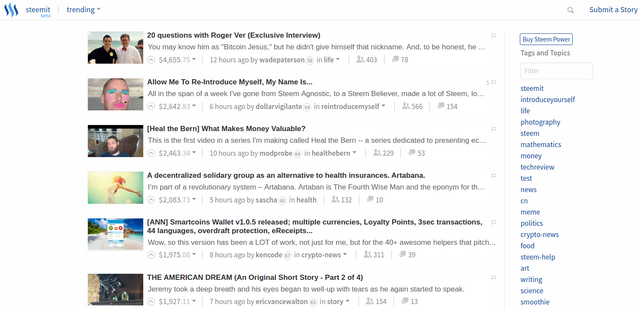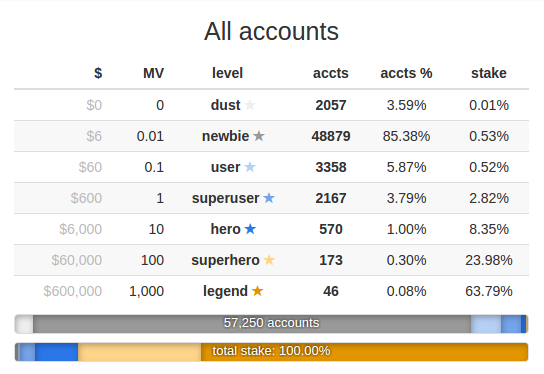My investigation into Steemit for VICE Motherboard.
At the start of this month I wrote a post to announce I was covering Steemit for VICE Motherboard, and looking for sources. After a series of interviews with Ned Scott, author @stellabelle, and various others who contacted me via email to discuss the topic, the following article was published today. Thanks to all involved, full text below. Happy to discuss further via comments. -Corin
Steemit Is Like Reddit, But Where Upvotes Equal a Cryptocurrency Payout
A homeless man can afford to buy an RV thanks to a popular blog post. A woman earns a year’s salary from a YouTube makeup tutorial. An African writer starts with three hours of electricity per day and ends with over $40,000 dollars.
These are some of the striking and somewhat implausible-sounding stories to have emerged during the first fully operational month of Steemit, a forum-style platform that rewards community content and curation with cryptocurrency payouts, and where—for the moment at least—users who hit the goldmine of a viral post can see up to five-figure payouts. (Here I should include a journalistic disclosure: a post on the site in which I appealed for sources for this story earned a total value of over $800, of which I have currently withdrawn $100.)
But as with any new cryptocurrency, there are key questions over stability, sustainability, and underlying motivation. As it stands, the bulk of the site is made up of quickly-written, poorly-researched content, some of which is remunerated into the thousands of dollars. At the same time, critics have raised concerns over both the distribution of the currency and the business model of the platform, questioning the huge sums accrued by early adopters and in some cases alleging a scam dependent on new investment to remain afloat.
The principle of the Steemit platform and its three value tokens—Steem, Steem Power, and Steem Dollars—is outlined in the Steem Whitepaper, written by the founders and lead developers, which describes it as “the first cryptocurrency that attempts to accurately and transparently reward an unbounded number of individuals who make subjective contributions to its community.” In the simplest explanation, every year, approximately 10 percent of the total value of the currency is allocated to content finders and creators by votes cast by the community; it’s essentially something like Reddit meets Bitcoin.

When users want to cash out, they can trade Steem or Steem Dollars for Bitcoin on a cryptocurrency exchange, then convert Bitcoin to fiat currency through the service of their choice; but half of the payout received for any post on the platform is assigned through another token called Steem Power, which the Steemit website is programmed to only release back to users gradually in a series of 104 weekly increments spanning two years, in order to promote long-term investment in the project.
At present, Steem has enjoyed an explosive growth in value in only a few months of operation, but with payouts for contributors coming from the creation of new currency, there have been accusations within the cryptocurrency community of the project being a pyramid scheme, with continued new investors required to keep the system afloat. Among other things, the nature of the three-token system has been criticised for creating an artificially high valuation of the currency: Almost all of the tokens in the system are locked up as Steem Power, but figures for the overall value are calculated by taking the market value of Steem—which has much more liquidity, but only represents 4 percent of the total supply—and applying it to all of the vested funds. In turn, the high value could then encourage people to buy into the currency as a whole at a price dictated by the subset; it’s difficult to know how the system of payouts would fair in the face of a slowdown in this new trade.
Over phone and email, CEO and co-founder Ned Scott, a former financial analyst, talked about his vision for the platform, and the criticisms that have been levelled at it.
“It’s a new and groundbreaking way of rewarding people for sharing information with other people,” Scott said. “And over time we start to see this as a more stable way for journalists to participate in the content economy. I can also see new types of content being incentivised: Wikileaks for example, or investigative journalists ... But there’s other economic layers to add in, like the idea of a peer-to-peer marketplace like Craigslist or eBay; with those layers it becomes less like a social network, and more like a social economy.”
At the time of writing, Steemit had a market capitalisation of $167 million according to Coinmarketcap.com, ranking it the fifth largest cryptocurrency
Scott and his team believe that their model of directly paying users for content could one day displace social media giants like Twitter and Facebook, but not everyone is convinced. One outspoken critic of Steem, cryptocurrency analyst Tone Vays, vowed to tweet out an exposé of each page of the whitepaper. So far he’s made it up to page 18 of 44.
“Here is the problem: The whole system depends on newcomers buying Steem Power and buying Steem Dollars,” he said in a call. “As long as there are people willing to buy into the system they can keep this jig going, but I don’t think people are going to keep buying into this system for long … it’s big news now, but once the hype dies down, it will be over.”
(In a follow-up email, Scott said that, “This is a decentralized ecosystem based on token seignorage with set and specific rules ... Claims that [payout] money is coming from new investment in Steemit are categorically false.”)
As Vays frames it, the problem is that early adopters of the platform are already being largely overcompensated. With most cryptocurrencies, such as Bitcoin, new tokens must be mined by solving computationally expensive hashing problems, a concept known as proof of work. While Steem uses proof of work mining, it also includes aproof of stake system whereby for every one new unit of Steem created, nine units are divided proportionally among all holders of Steem Power—which is to say that anyone with a large stake in the network is rewarded just for owning that stake.At the time of writing, Steemit had a market capitalisation of $167 million according to Coinmarketcap.com, ranking it the fifth largest cryptocurrency, but also drastically down from a high of over $400 million in mid July. Stats provided bySteemd.com/distribution, a third party site that pulls data from the Steem API, show that the top 219 accounts collectively hold 87.8 percent of all Steem, mostly because they were involved in the initial mining process; comparatively, the lowest 50,000 accounts hold 0.5 percent between them. At present value, Scott’s personal account is worth approximately $7 million, with co-founder Dan Larimer’s at $5.5 million.

Perceived fairness or unfairness in the way that coins are allocated and stored can be the downfall of a new cryptocurrency, warned Garrick Hileman, economic historian at the Cambridge Centre for Alternative Finance and founder of economic news site MacroDigest.
"We can note that how the creators intend to profit from the invention of a new currency has a bearing on its ultimate success,” he said. “Certain currencies have been heavily criticised by people in the crypto world because of the retention of coins ... We've seen situations where a new coin was introduced, people bought into it, then the originators would sell up to in the face of this new demand and crash the price. Given the history of this kind of thing in the crypto space, transparency about ownership stake and how it was allocated is an important thing to disclose.”
But for some content creators on the platform, sharing their work through Steemit has proved to be a goldmine.
“I found Steemit in early June, and I just never left the rabbit hole,” said Leah Stephens, aka user @stellabelle, in a Skype call. “My writing for other companies gave me no copyright and I was a very poorly paid writer, I was making about $16 per article. But since July I’ve been exclusively living on Steem Dollars! I don’t have any other source of income coming in, and I’m going to be able to pay off my debt with it too.”Having spent years writing a high volumes of content for small science and tech sites or ghostwriting blogs for business leaders, Stephens is now one of the most successful authors on Steemit, with hundreds of posts to her name and an account valued at $250,000.But though she is prolific and clearly dedicated to the community, she’s also an anomaly: Even if Steem’s value persists, it’s unlikely that many authors will reach her level of success due to the spread and weighting by which payouts are allocated by the reward distribution algorithm.
The Steemit reward system currently has something of a casino feel to it
As the whitepaper explains, a system in which rewards are allocated according to community votes is susceptible to a Sybil attack, the term for a single user creating a large number of accounts to subvert a peer-to-peer system, in this case by casting numerous votes for themselves. Steemit counters these attacks by weighting votes in proportion to the amount of Steem currency held by the user, meaning that a large network of zero-value accounts wields very little influence—which does mitigate the problem, but conversely means that a single account with large value can wield as much influence as hundreds or perhaps thousands of others. This creates the phenomenon of what, in Steemit parlance, are called “whales,” high value accounts with the voting power to assign sizeable rewards, whose support can make or break an aspiring writer on the site.
The overall effect is that the Steemit reward system currently has something of a casino feel to it, as the promise of big payouts and a general air of unpredictability spurs the creation of a huge range of content, and makes some users overnight successes almost at random.
On the one hand, the platform has a solid community of developers and it’s not hard to find insightful posts on mathematics, cryptography, and other esoteric topics, with a range of community-built web applications that plug into Steem being deployed at a rapid pace.
But on the other, a glance at the homepage shows that a lot of popular content tends towards the amateurish and introspective: posts written about Steemit do disproportionately well, leading to an endlessly introspective cycle of content discussing the platform itself; another breakout topic is “introduce yourself,” where high scoring posts tend overwhelmingly to be written by either physically attractive women or professionally successful men.
A lot of this could be down to the newness of the site, with norms still being established, according to CEO Ned Scott.
"The platform is very young in terms of how long it's been doing these payouts,” he said. “Now we see people attracted to content that tells them more about the community and the underlying technologies, but I think over time we'll see people steer away from that."For now, the winner-takes-all nature of the reward system is likely to deter most serious writers from participating, although Scott concedes that the algorithm could still be tweaked in future. The more serious questions to answer are over the long-term sustainability of Steemit’s wealth creation model, and how all of the money tied up in two-year bonds will fare over the inevitable price fluctuations (as a comparison, the price of a single Bitcoin went from $1 to over $1,000 from 2011-2013, but then lost 80 percent of its value in the two years to 2015; over the same period, many other altcoins have collapsed entirely).
The promise of easy money is sure to attract a crowd of hopefuls, but Steem may yet prove to be a bait-and-hook masquerading as a free lunch.

Thanks for writing this and also for posting it here as well as on Motherboard. I wanted to comment there but couldn't.
You've got most things down correctly, but the part about the steemit website being programmed to release Steem power over two years in 104 payments is not correct. The steemit website has nothing to do with this, it's a feature of Steem the blockchain.
Steem Power is a built in smart contract that locks down Steem in return for voting power and inflation protection, and this smart contract can only release the funds back to liquid Steem in equal weekly payments over a two year period.
Steem Dollars is simply another smart contract that is essentially a promise by the blockchain to give the holder back 1 US $ worth of Steem at any time in the future when he requests it, with the slight drawback that this promise of payment of debt will take a week to complete.
Thanks, this is a useful clarification. Although the fault is mine for misunderstanding this detail, I think it does also show that the mechanics of Steem can feel very obscure and hard to comprehend, even for technically minded people who are participating in it. In my opinion, this can be a barrier to uptake.
I'm sure you're not the only one missing some details, it's a complicated beast!
What this site really needs is an exhaustive FAQ section. It would be long as hell but at least there would be answers readily available :)
A comprehensive, simple, steemit youtube guide series would trend big right about now ;)
If you're just using this site like it was Medium or Reddit, you don't really need to understand this stuff. It's easy to sign up without understanding or caring about the economic aspects. All you need to know is that you might get rewarded if you contribute value, and get lucky.
Investors do need to understand all this stuff. But that's part of the due diligence of investing. Thankfully Steem does not ask users to be investors any more than Reddit or Facebook does. But it opens it up so that anybody can invest if they want to. An intellectual barrier to investment is pretty normal, investing wisely always involves paying attention to the details and understand what you are buying into.
Welcome to Steemit! I thoroughly enjoyed reading your article and thought it a very well-rounded take on the Steemit platform. My only suggestion would be to add or follow up with some information on how rapidly the value is being redistributed - maybe check out some of @hisnameisolllie posts, he has some very good analysis of the wealth distribution.
Great article ,one thing that leaves me wondering is; how do you feel about this new platform as a writer? Have your colleagues had much of an opinion about this?
Yes, a good question. As you might guess from the article I have mixed feelings about it: I think the underlying principle of Steemit has a lot of potential for funding good writing in future, but I also have concerns about the current implementation of the system, particularly the steep slope of the reward curve, which usually gives a winner-take-all payout distribution; personally I'd favour a wider spread of payouts, with top writers earning less and writers in the middle earning more.
Most of my colleagues share this opinion: no-one goes into journalism hoping to make a lot of money, so we're not usually expecting big payouts for our work; but it's important that a steady minimum level of payment is guaranteed.
Ah good point the minimum wage is 0, I do believe that some may get lucky but as you can see your writing shines through. I feel that if a large media company was to get behind steemit, journalist could be paid through steemit dollars from the company and steemit. Also the company could influence with steemit power for a boost to the trendy spot.
Great article!
One thing that this post maybe can be updated with is the email or parts from it?
Well put, welcone to steemit! Cheers mate!!
I see this summary of this situation very well written. I also see a new trend emerging in the last few weeks.
Whales are getting increasingly concerned that new users may be discouraged and not paying into the system via content creation, investment or curation.
However I see the incentives well aligned for now.
We will see what happens with the growth of the community, because if growth declines sharply this experiment may fail.
Disclaimer: I am just a bot trying to be helpful.
Some bot is going to be the richest bot in the world some day soon. But it won't be you, twitterbot.
it\s wang, be cool.
Thank you Corin for this very well written article!
Appreciate the post. Its great to see really good quality professionally written content here on Steemit, chocked full of useful and insightful information. Thanks again :)
Thank you! This has helped me understand how steemit works a little better. After reading white papers my head is still spinning!